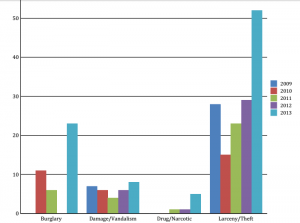
by Aaron Schmelzer | May 9, 2014 | News Slider
Lipscomb has a generally good reputation concerning the amount of crimes that occur on campus. But, the Tennessee Bureau of Investigation’s 2013 crime statistics show that the school ranks near the top of the list in comparison to nearby colleges with the number of reported burglaries and thefts. The amount of reported larcenies and thefts have gradually increased from 2010. In 2013, there were 52 reported larcenies/thefts, while in 2012, there were 29, a difference of 23 reports. The difference between burglaries and thefts/larceny, as Lipscomb Assistant Director of Campus Security Patrick Cameron described, is a matter of where the crime occurs. “If you leave your dorm room unlocked, [and] somebody comes in and steals your wallet out of your dorm room, it still counts as a burglary because it’s your residence,” Cameron said. He went on to say that theft occurs when an possession is stolen from a public place that the thief has permission to be in. To the left are the 2013 statistics compared to the past few years. Sophomore molecular biology major Mark Mitchell was a burglary victim last year. He and his roommate left their door unlocked at night quite often, and the money in his wallet was stolen. “I had [about] 100, 200 dollars in my wallet, in my desk, tucked away,” Mitchell said. The thief had walked into his room, taken the money and left. Though Mitchell was stolen from, his outlook on Lipscomb hasn’t changed. He does, however, encourage students to be more aware. “People need to be aware,” Mitchell said. “You need to recognize that this is not a bubble....
by Aaron Schmelzer | Jan 22, 2014 | News Slider
In the midst of Nashville’s unusually cold winter, Lipscomb Assistant Director of Campus Security Patrick Cameron stressed the need for preparation during times of cold weather. Here are a few tips to help yourself during these cold months. “Dress warmly in layers,” Cameron said. This included head and ear protection and gloves. “Check the weather forecast. Be aware of what’s going on.” He mentioned that knowing what the forecast will be before you go outside can help you make attire decisions and be better prepared for possible bad weather. “Limit your exposure [to the cold weather],” Cameron said. “Stay inside as much as possible.” When it comes to driving, Cameron encouraged students to “always allow extra time for travel. In the winter months, you may need to let your vehicle warm up more.” Not only will it be a warmer ride to school if you commute, but it is better for the vehicle to warm the engine. He also said to keep an extra jacket or blanket in your car in case of emergency. Cameron stressed the need to be careful of black ice when driving. Black ice is ice that blends into the asphalt on the road and can be hazardous to drivers. Because of this and other winter weather, Cameron encourages students to “drive slower that you normally would.” He also said to inform others of your plan for safety’s sake. If anything happens in the bad weather, there will people who know where you’re supposed to be and when. Because night falls faster this time of year, Cameron encouraged those who travel on campus at night to use...


